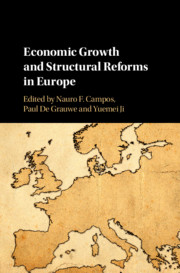Book contents
- Economic Growth and Structural Reforms in Europe
- Economic Growth and Structural Reforms in Europe
- Copyright page
- Contents
- Figures
- Tables
- Contributors
- Introduction
- Part I Economic Growth and Structural Reforms in Europe
- 1 Euro Area Growth and European Institutional Reforms
- 2 Structural Reforms and Growth
- 3 Regulation, Institutions and Economic Growth in Advanced, Emerging and Developing Countries
- Part II Macroeconomic Implications of Reforms
- Part III Case Studies
- Conclusions
- Index
- References
2 - Structural Reforms and Growth
The Elusive Quest for the Silver Bullet
from Part I - Economic Growth and Structural Reforms in Europe
Published online by Cambridge University Press: 31 March 2020
- Economic Growth and Structural Reforms in Europe
- Economic Growth and Structural Reforms in Europe
- Copyright page
- Contents
- Figures
- Tables
- Contributors
- Introduction
- Part I Economic Growth and Structural Reforms in Europe
- 1 Euro Area Growth and European Institutional Reforms
- 2 Structural Reforms and Growth
- 3 Regulation, Institutions and Economic Growth in Advanced, Emerging and Developing Countries
- Part II Macroeconomic Implications of Reforms
- Part III Case Studies
- Conclusions
- Index
- References
Summary
Structural reforms are often presented as a growth panacea. We review this concept through two separate analyses. First, we quantify the impact of wide-reaching reform packages implemented in twenty-three countries worldwide. Second, we look at the role that reforms had in contributing to spark 135 growth accelerations, i.e., positive up-breaks in growth patterns. All in all, our results point to the fact that deep economic reforms can have an important impact on a country’s growth rate but, often, they fail to deliver their benefits and, in some instances, they can even be detrimental. In achieving economic growth, there are no silver bullets. Rather, economic reforms should be framed as an opportunity that, if appropriately tailored to country-specific needs and well implemented, could yield important benefits.
- Type
- Chapter
- Information
- Economic Growth and Structural Reforms in Europe , pp. 37 - 62Publisher: Cambridge University PressPrint publication year: 2020



